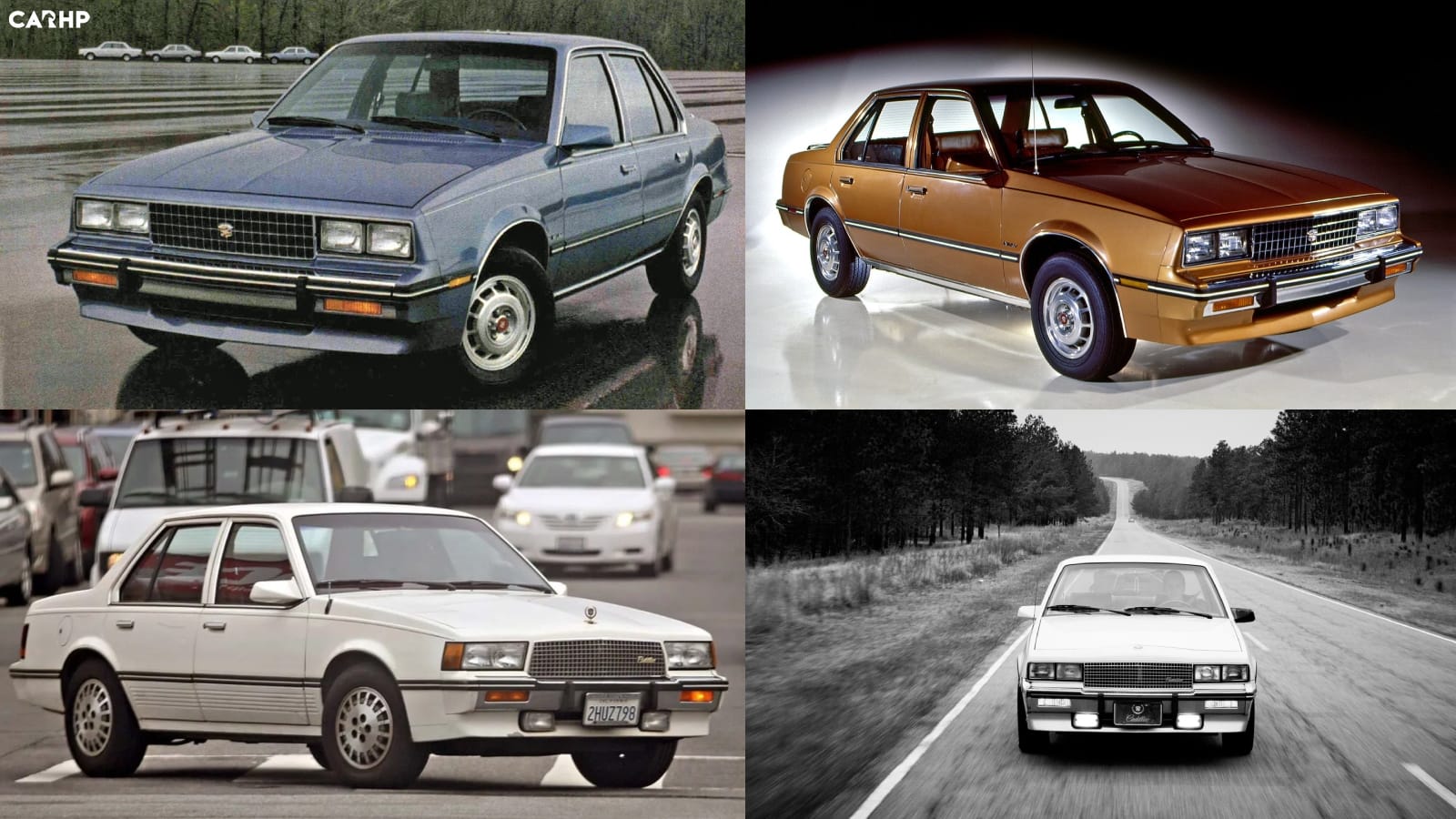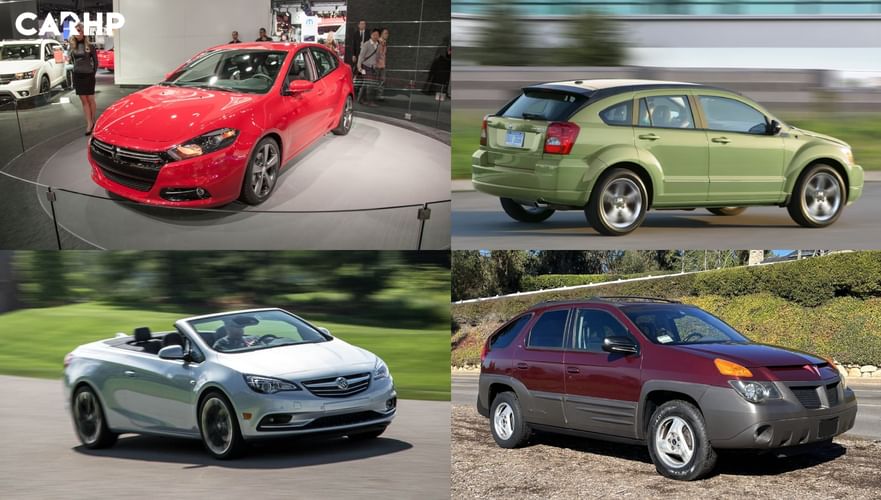In the fast-paced competitive world of the automobile industry, not every car can be a masterpiece. There are vehicles that, for one reason or another, end up being considered "crappy" by critics and enthusiasts alike. Ranging from the maligned Cadillac Cimarron to the quirky Pontiac Aztek, these cars overcame their reputations as 'crappy cars' and connected with certain niches of American buyers. Factors like affordability, unique styling, and versatility helped these less-than-stellar models find homes, even if they failed to match the success of more beloved vehicles. However, in a curious twist of fate, some of these cars manage to achieve decent sales figures despite their lackluster reputation. In this listicle, we take a closer look at the top 10 crappy cars in the US that fall into this category, exploring what made them less than stellar and how they still found a place in the garage (or driveways) of American consumers.
10. Cadillac Cimarron

The Cadillac Cimarron, essentially a rebadged Chevrolet Cavalier with some luxury features, was widely criticized for its lack of true luxury and value. Nevertheless, The Cadillac Cimarron, produced by General Motors under the Cadillac brand from 1981 to 1988, aimed to compete with European luxury cars like the BMW 3 Series and Mercedes-Benz 190E. However, despite its luxury branding, the Cimarron faced criticism for its quality, performance, and high price and overall being a crappy car. It garnered a reputation as a "badge-engineered" car, lacking significant improvements over its less expensive counterpart, the Chevrolet Cavalier.
Sales were disappointing, with only 132,499 units sold over eight years, far from the initial target of 20,000 units annually. The Cimarron's lack of differentiation from the Cavalier, underpowered engine, cheap interior materials, and subpar handling contributed to its decline, symbolizing Cadillac's struggles in the 1980s. Despite an attempt with the Cadillac Cimarron D'Oro in 1988, the model was eventually discontinued.
9. Ford Pinto

The Ford Pinto, produced by Ford Motor Company from 1971 to 1980, aimed to offer a budget-friendly and fuel-efficient choice for consumers. Despite its controversial design and safety concerns, it managed to sell over 3 million units during its production years, driven by its affordability and the 1970s demand for smaller, efficient cars.
Unfortunately, safety issues were a significant drawback, as its rear-mounted fuel tank made it susceptible to ruptures in rear-end collisions, resulting in fatalities and injuries. Moreover, reliability problems and subpar build quality further eroded consumer confidence. Its unattractive design and lackluster performance also deterred buyers, contributing to its downfall. Additionally, a notorious legal case in 1978, where Ford faced reckless homicide charges for the fuel tank design, added to the car's negative image, though the company was ultimately acquitted. Its low price point and compact size attracted buyers who were willing to overlook its glaring safety issues.
8. Yugo GV

The Yugo GV, produced by Yugoslavian automaker Zastava Automobiles from 1980 to 2008, found a place in the annals of automotive history for its less-than-stellar performance. In the US, where it was available from 1985 to 1991, approximately 141,651 units found buyers. Marketed as an affordable option, the Yugo GV suffered from quality control issues, manifesting in poor build quality, unreliable engines, and safety concerns, tarnishing its reputation. Hated by both consumers and critics, it earned the dubious distinction of being one of the least esteemed cars ever made.
This subcompact car, based on the Fiat 127, featured a 1.1-liter engine with 55 horsepower, a four-speed manual transmission, a top speed of 86 mph, and a 0 to 60 mph time of 14.5 seconds. Despite its notoriety, the Yugo GV did manage to achieve decent sales during its US stint. However, its incredibly low price made it appealing to budget-conscious consumers, leading to over 141,000 units sold before its eventual demise.
7. Pontiac Aztek

The Pontiac Aztek, often described as one of the ugliest cars ever produced, was a commercial failure for General Motors. The Pontiac Aztek, produced from 2001 to 2005, achieved modest success with 119,000 units sold. Its inclusion in the list of top 10 poorly received cars with strong sales underscores its unique story. Its unconventional, divisive design featured a boxy frame, clashing lines, and peculiar proportions, diverging from traditional SUV norms made its entry into the list of the most ugly SUVs of its time.
The interior faced criticism for its budget materials, uncomfortable seating, and outdated tech. Performance-wise, the 3.4-liter V6 engine produced 185 horsepower, somewhat underwhelming for its size. Handling suffered from a soft suspension and noticeable body roll. Despite these drawbacks, its versatility and adventurous spirit, exemplified by features like a removable rear seat and a tent package, have led to a cult following despite being a shity car, appreciating its quirky charm and practicality. Notably, it gained fame through its appearance in the popular TV show "Breaking Bad."
Also Read:
6. 2015 Chrysler 200

The 2015 Chrysler 200, a midsize sedan, saw decent sales, with approximately 177,889 units sold in the United States. While not reaching the heights of some popular models, it was a noteworthy figure for a car facing criticism. Several factors contributed to its challenges, including lackluster performance, interior, and transmission. Tough competition from rival midsize sedans offering better value and reliability added to its woes. Criticisms included cheap materials, uncomfortable seats, and outdated technology, impacting its consumer appeal.
Nevertheless, it boasted a sleek exterior, a quiet cabin, and optional all-wheel drive. Ultimately, the 2015 Chrysler 200 was succeeded by a redesigned 2017 model that addressed its flaws. The new version garnered more positive reviews but was later discontinued in 2018 as Chrysler shifted focus to SUVs and trucks. The 2015 Chrysler 200, despite being a significant improvement over its predecessor, still struggled to compete with rivals in its segment. However, its stylish redesign and comfortable interior helped it find homes with nearly 178,000 buyers during that year.
5. 2016 Buick Cascada

The 2016 Buick Cascada, a compact convertible, faced challenges in a market dominated by larger and more established competitors. Nevertheless, it attracted a niche audience, who appreciated its open-top driving experience and elegant design. In 2016, the Buick Cascada made its mark in the US, with 7,153 units sold, a noteworthy feat for this compact convertible.
However, it faced challenges, primarily attributed to its high price, limited marketing efforts, and stiff competition in the convertible segment. Critics and consumers alike were less than thrilled with its performance, technology, and practicality. Under its hood, a turbocharged 1.6-liter four-cylinder engine paired with a six-speed automatic transmission powers the Cascada, while its interior offers leather upholstery, heated front seats, and a seven-inch touchscreen infotainment system. These factors collectively contributed to the 2016 Buick Cascada's recognition as one of the top 10 underwhelming crappy cars that managed decent sales in the US.
4. Dodge Caliber

The Dodge Caliber, a compact car produced by Dodge from 2006 to 2012, was marketed as an affordable and versatile vehicle. However, it fell short of expectations and garnered criticism for its subpar quality and design for its low-quality interior materials and uninspiring driving experience.
In its best year, 2007, it sold over 200,000 units in the US, but subsequently, its sales plummeted due to these shortcomings, leading to its discontinuation in 2012. This model received widespread disdain from both consumers and critics, primarily due to its inexpensive interior, uncomfortable seating, and lackluster performance. Furthermore, it grappled with reliability issues, such as transmission and suspension problems.
3. 2003 Chrysler Crossfire

The 2003 Chrysler Crossfire, a two-seat sports car born from a Chrysler-Daimler-Benz collaboration and inspired by the Mercedes-Benz SLK, graced the automotive scene from 2003 to 2008. Regrettably, its presence failed to ignite the American market, with just 28,000 units sold in the United States over its five-year tenure. This muted reception stemmed from a combination of factors. First, its relatively high starting price of around $35,000 made it a pricier choice within the Chrysler lineup.
Additionally, when compared to rivals in its price range, the Crossfire fell short in terms of equipment. Its performance also lacked the vigor one might expect, given its sporty aesthetics, largely due to its weight and a 3.2-liter V6 engine producing 215 horsepower. Practicality suffered as well, with cramped confines and limited cargo space, rendering it less suitable for daily life. Styling opinions were divided, with some lauding its uniqueness and others finding it polarizing. Ultimately, the 2003 Chrysler Crossfire, discontinued in 2008, earned a reputation as a less-than-stellar car due to its lackluster sales, modest performance, and divisive design.
2. 2018 Buick Regal

The 2018 Buick Regal, a midsize sedan, achieved modest sales in the US despite its reputation as one of the less favored cars. Approximately 14,118 units found buyers, a respectable figure for a car with less acclaim. Lackluster design, performance, and formidable competition were major contributors to its underwhelming sales performance.
Criticized for its uninspiring driving experience, subpar interior quality, and dated technology, the Regal struggled to make a positive impression. However, it did offer a comfortable ride, a spacious interior, and a variety of features. Still, its appeal was overshadowed by stronger alternatives in the midsize sedan market. For those valuing comfort and space over performance and modern amenities, the 2018 Buick Regal had its merits, but it faced tough competition.
1. 2013 Dodge Dart

The 2013 Dodge Dart, introduced with high hopes, faced criticism for its lackluster interior quality and uninspiring performance. The 2013 Dodge Dart marked the return of a classic nameplate last seen in 1976. A product of the collaboration between Chrysler and Fiat under the Fiat Chrysler Automobiles (FCA) partnership, the Dart arrived with a stylish design, roomy interior, and a diverse engine lineup, including a turbocharged variant. Built on FCA's Compact U.S. Wide (CUSW) platform, it garnered initial acclaim.
However, challenges arose, notably in the form of lackluster performance, handling, and subpar interior quality. These shortcomings contributed to below-average reliability ratings and hampered the Dart's appeal. Competition from established models like the Honda Civic and Toyota Corolla added to its struggles. While 2013 saw 83,388 units sold, far from the projected 250,000, subsequent years witnessed a continuous decline in sales, with 83,858 and 87,392 units sold in 2014 and 2015, respectively.
CONCLUSION
In conclusion, these ten cars may not have been automotive icons, but they found a place in the American market due to factors like affordability, practicality, or unique features. Their sales success serves as a reminder that not every vehicle needs to be a masterpiece to resonate with consumers. While these cars may have been considered "crappy" by some, they managed to find their niche and make their mark in the annals of automotive history as the top 10 crappy cars in the US that managed to rack up decent sales.
Also Read:

